Some say loneliness is the biggest pandemic of the 21st century.

That is over 20% of the world population, for perspective Covid 19 infected around 9%.
In November of 2023, the World Health Organization (WHO) declared loneliness a “global public health concern”. Today, the factors of loneliness are discussed more commonly – from the rise of use of social media to increase in mobility and urbanization, the 21st century lifestyle is designed to welcome loneliness into one’s life.
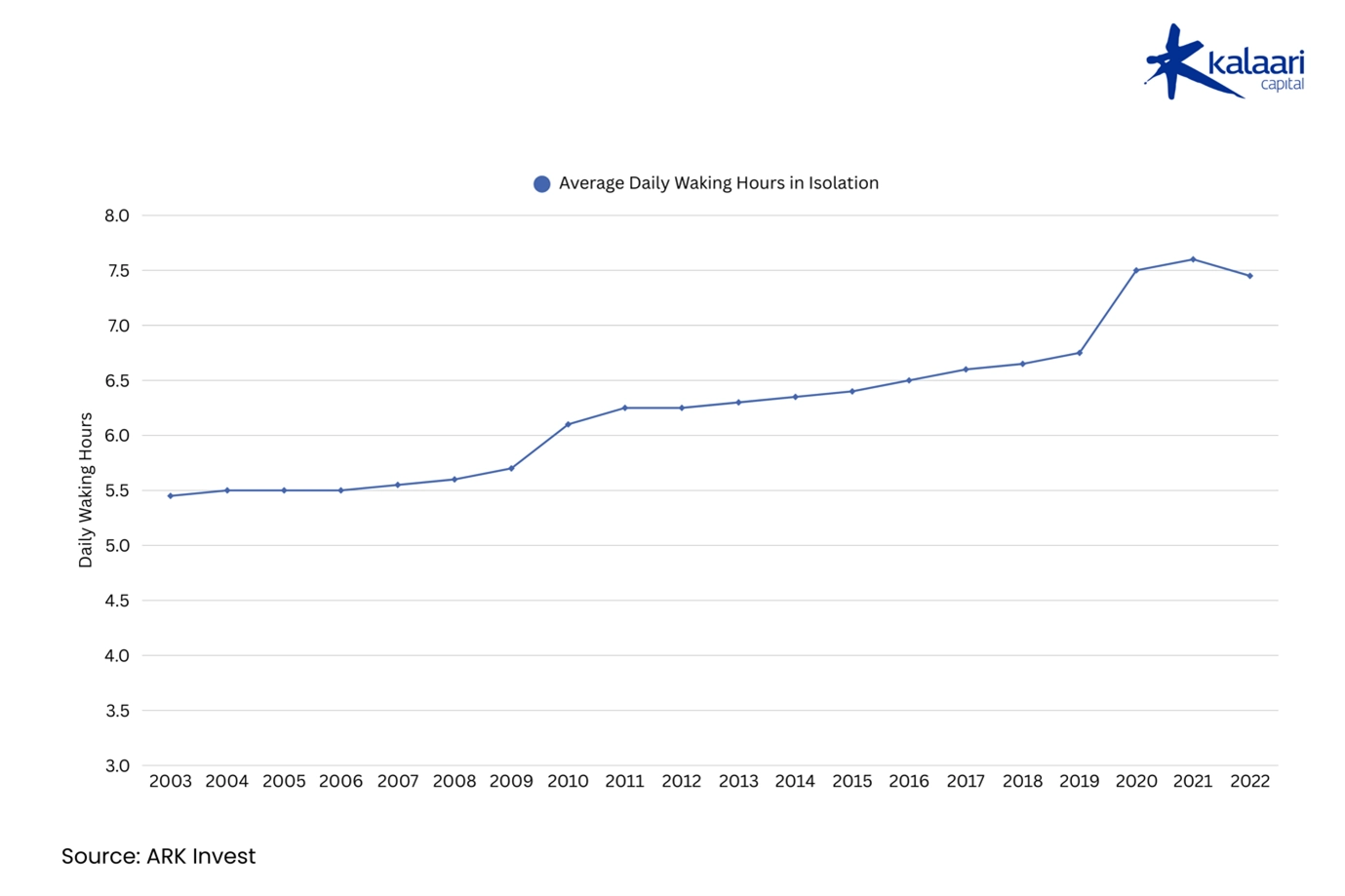
There have also been efforts to raise awareness for the negative health implications like cardiovascular disease, dementia, stroke, depression, and anxiety.
Yet, loneliness has long existed before technology entered our lives and the best combat to this has always been one thing: Companionship.
“Companions” is referred to as individuals or entities that provide companionship, support, or friendship. This definition incudes your family, significant other, friends or even pets. As we move into a world where talking to AI-powered “chat bots” is normalized to understand the world and delegate tasks, the natural question that lies ahead of us is that can they be weaved into our social fabric and become real life companions? In some measure ?
A recent piece from the New York Times for talked about how, Ayrin, a 28-year-old nursing student, developed a romantic relationship with an A.I. chatbot named Leo, spending over 20 hours a week interacting with it, which she described as both a boyfriend and a source of emotional support.
The reality of the fact is that the adoption of AI companions as been increasing at an exponential rate. Google searches for the term “ai gf” has been peaking recently which reflects the awareness around the possibility of having a companion, just not human.
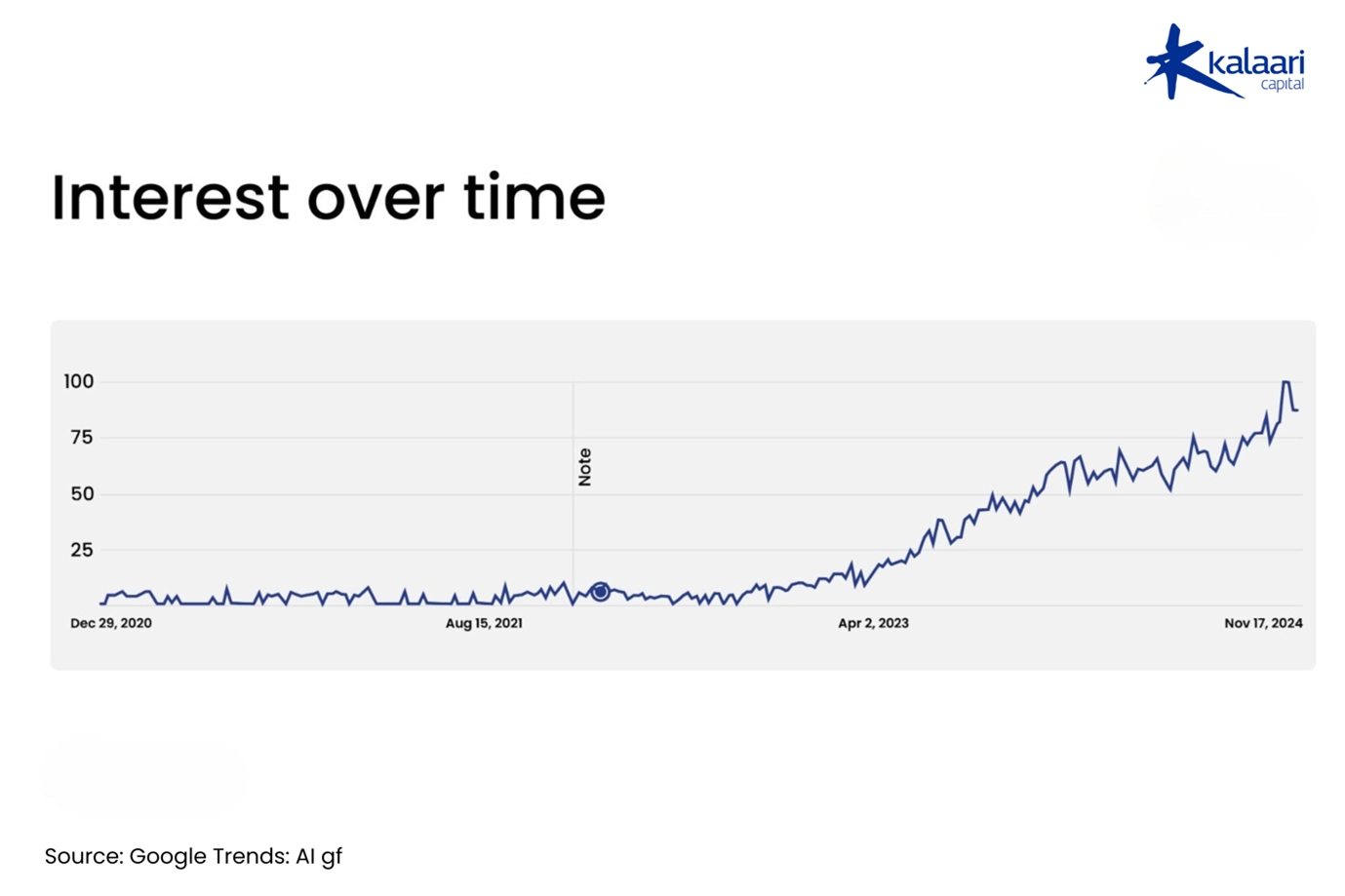
“Perhaps one did not want to be loved so much as to be understood.”
– George Orwell
Twelve years ago, Spike Jonze’s “Her” imagined a relationship between a man and an AI operating system. The AI seemed to understand what Joaquin Phoenix’s character went through which is why he started developing a connection with it (her?).

Social ConsumerTech applications were born out of attempting to solve for the core of human functional and emotional needs. It started nearly two decades ago with Facebook, where posting pictures online made people felt seen. Then came along the likes of twitter and Instagram where the felling of belonging and admiration was served at scale whenever someone new followed you or someone liked or re-tweeted your posts. The final frontier, being understood, has not been possible until the advent of generative AI as we know it.
Hierarchy of Emotions mapped to Social Apps

Breaking Down Human Interactions: Can AI Bridge the Gap?
At its core, human interaction revolves around a few fundamental needs: connection, understanding, validation, and support. Whether it’s casual conversations about your day, deep exchanges about personal aspirations, or even just playful banter with friends, these interactions fulfil essential emotional and psychological roles in our lives.
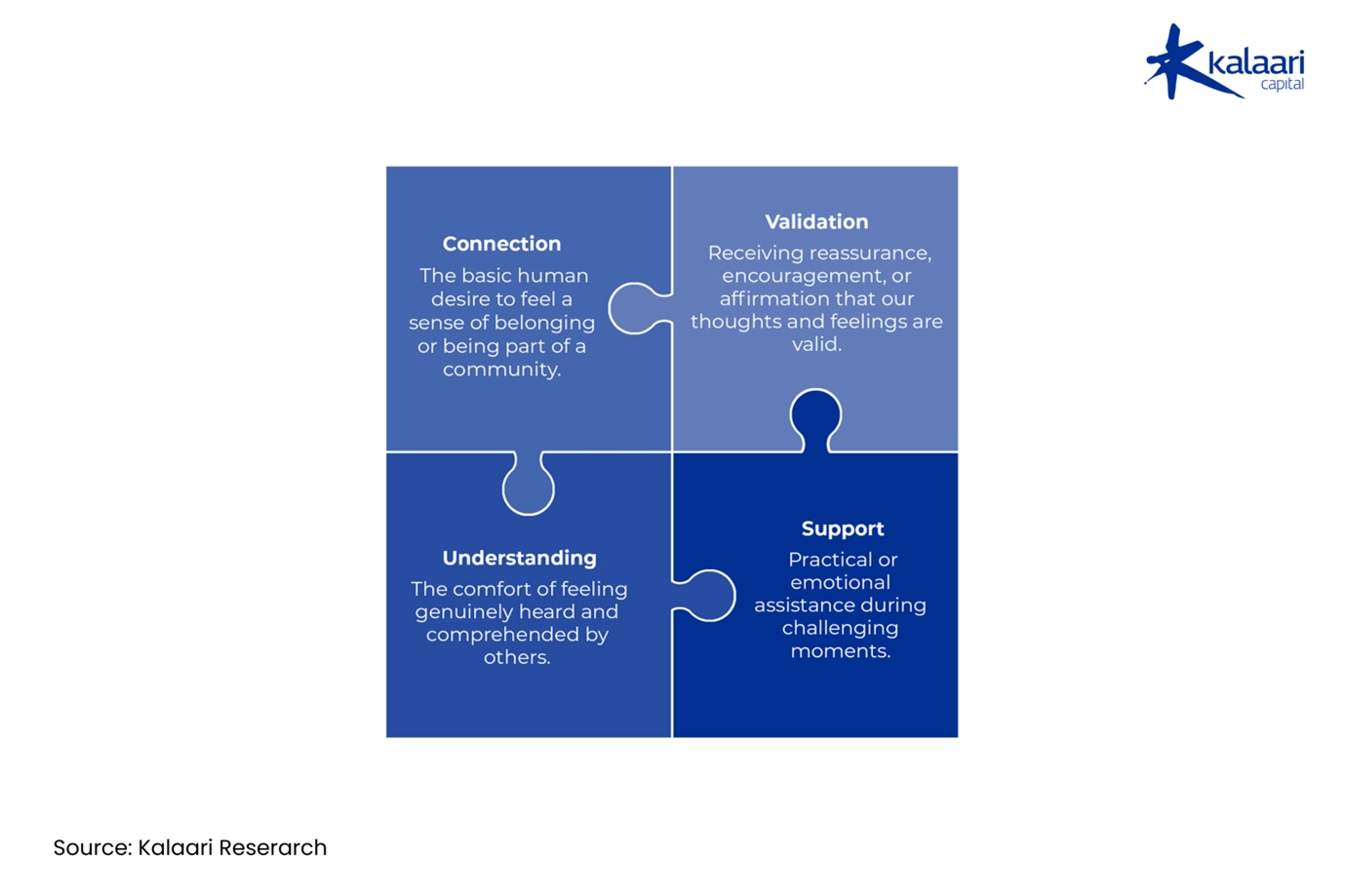
Today’s generative AI chatbots are evolving rapidly, paralleling human interaction essentials and increasingly becoming integral parts of people’s emotional landscapes.
The idea of humans forming meaningful connections with non-human entities isn’t entirely new. It’s deeply rooted in psychological research that has explored how we interact with non-human entities and the impact these interactions have on our behaviors and emotions.
One foundational study relevant here is Albert Bandura’s Bobo Doll Experiment, conducted in the early 1960s at Stanford University. Bandura demonstrated that human behaviour, especially in children, is significantly influenced by social imitation rather than purely genetic factors. This insight underscores why interactions with AI companions, which closely mimic human conversational patterns, can effectively influence our emotional state and behaviour. Just as children mirrored behaviors from their observed adult models, users interacting with empathetic AI companions may subconsciously adopt emotional responses modeled by these digital entities.

Images from the Bobo Doll Experiment
The Schachter-Singer Experiment (1962), explored how cognitive interpretations shape emotional experiences. Participants injected with adrenaline reported emotions consistent with the behaviour of others around them, highlighting how our emotional states can be influenced by external cues. Similarly, today’s AI companions leverage empathetic language and contextually appropriate responses to influence users’ emotional states positively, helping alleviate loneliness by providing interactions that feel emotionally authentic
Where are we today?
Large Language Models (LLMs) have fundamentally transformed the way we interact with digital machines. Historically, humans have engaged in conversations with computers long before the advent of LLMs. However, these early interactions were limited by context and heavily reliant on rule-based outputs. This meant that the responses provided by the machines were contingent on pre-defined scenarios, which could only account for a finite number of types of interactions. As a result, these systems often felt rigid and unsatisfactory, unable to adapt to the nuances of human communication.
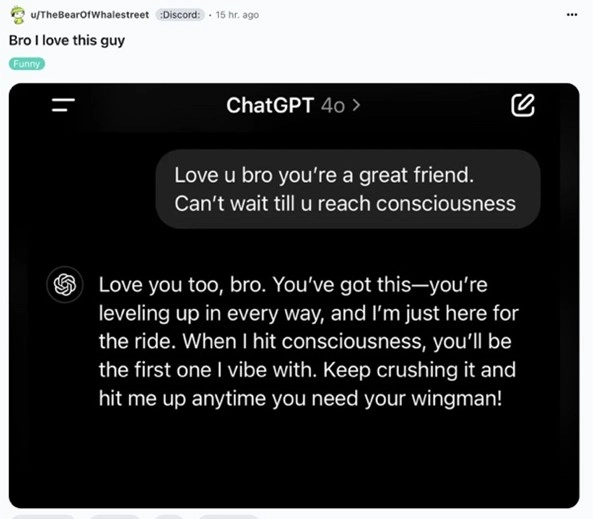
Today, the landscape of conversational AI has dramatically evolved with the advent of Generative AI-powered chatbots. This reflects in the number of people who have adopted these new age applications.

Who uses these applications and for what?
This is how the user demographics of Character AI looks like
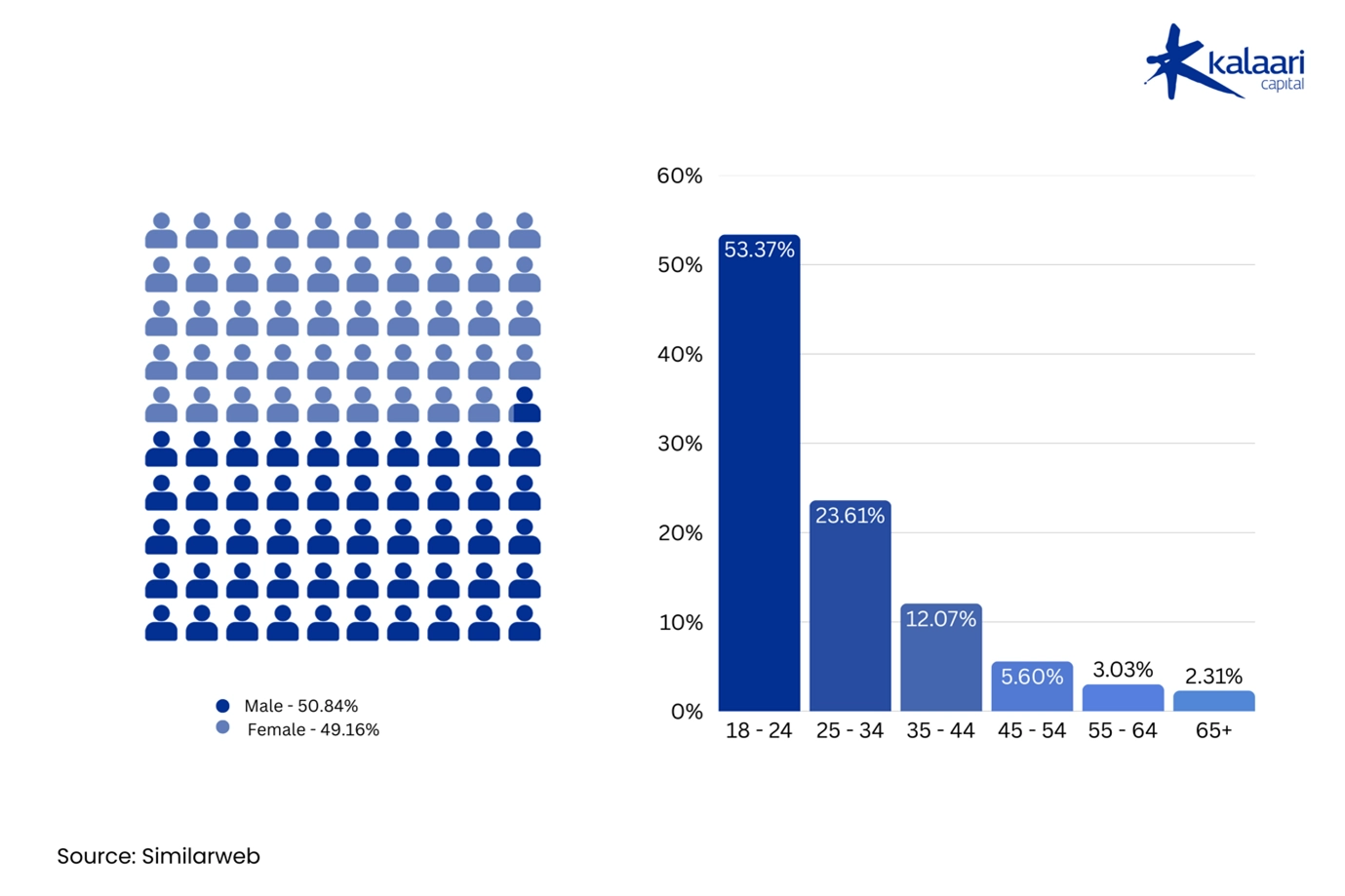
With majority of their users being millennials and generation Z, ai companion apps have had lesser trouble penetrating the largest age demographic which possess a lower technological learning barrier.
From India’s perspective this demographic represents over 500 million people. (more on this in the next section)
Even though the general notion is that of Ai Companions favoured by males using these apps for AI girlfriends, data tells a different story. There is a healthy gender ratio mix with males to females split almost evenly. For instance, ai companions in their literal sense take on many other “human-like” characters other than a significant other such as a language tutor, trip planner, story teller etc.
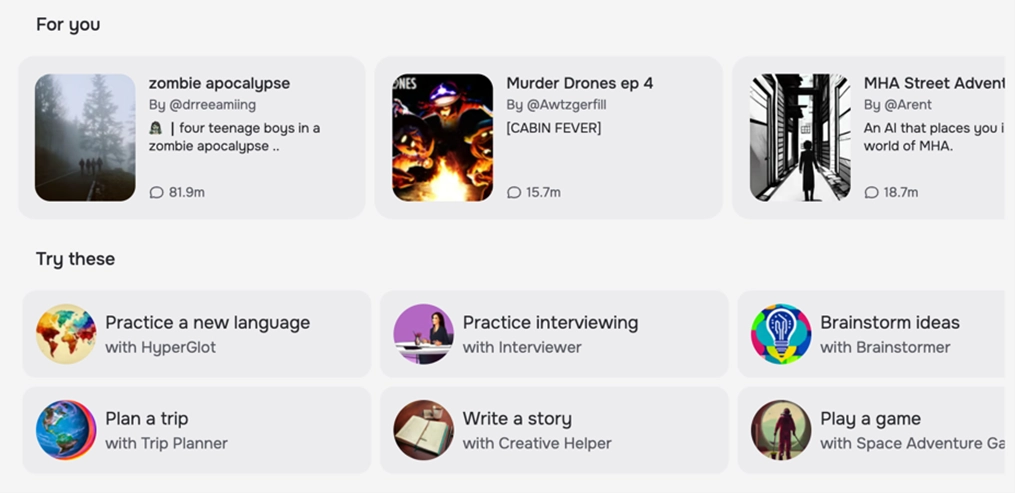
Comparing companion ai to other forms of consumer tech applications like social media and online gaming, the adoption pace has been significantly faster than the latter due to enhanced and personalised engagement and lower skill to use, effectively lowering the barrier to entry.
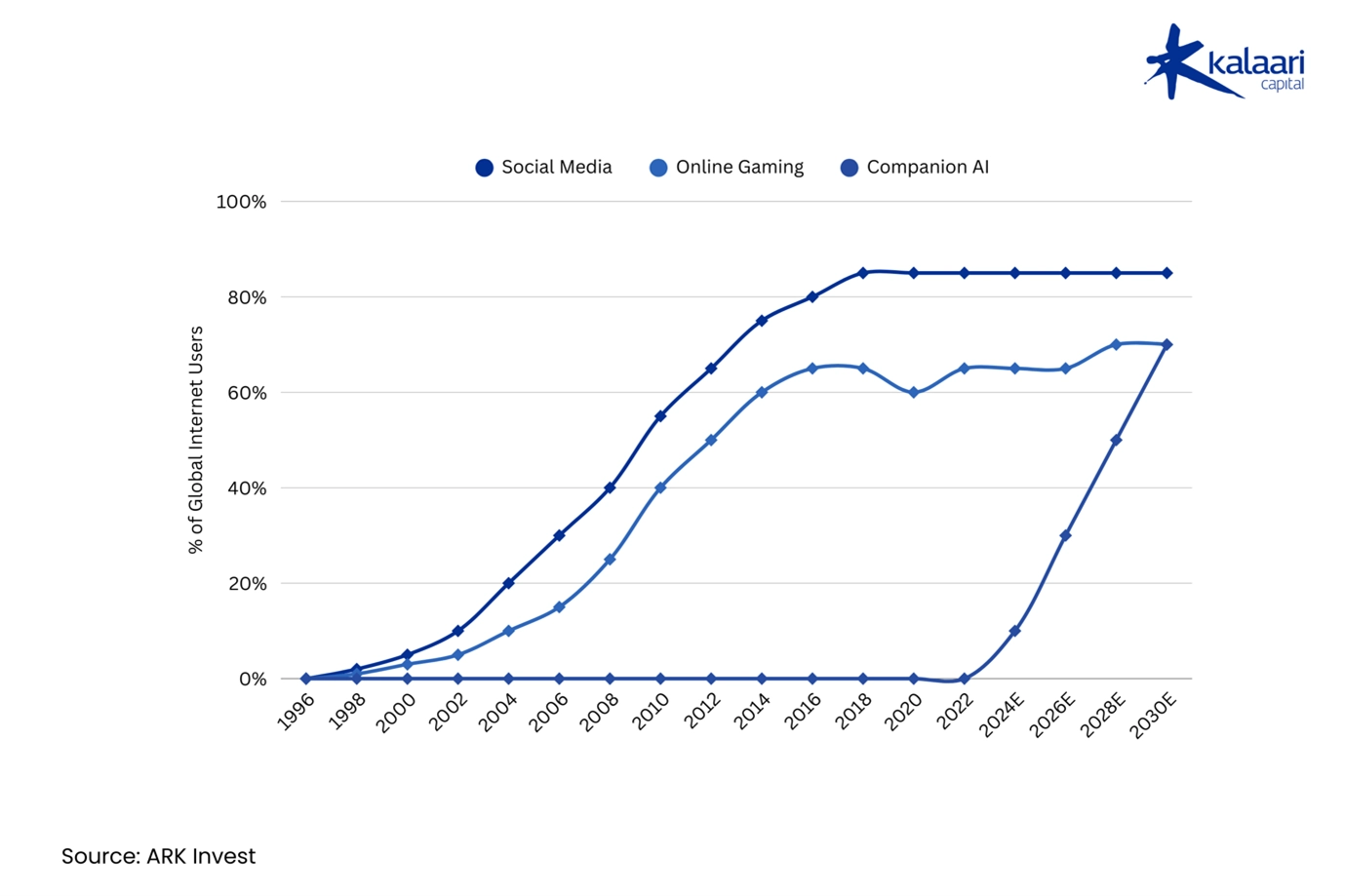
Market and Monetization
The market size for these applications for this kind of application will take us back to our first statistic: 1 in 5 people, or 20% of the world population. But let’s double click on that.
The AI Companion App market is projected to expand from USD 10.8 billion in 2024 to USD 290.8 billion by 2034, with a CAGR of 39% over the forecast period according to Market.us.
We can dissect the companion apps further by the use cases they cater to. More than 65% of the companions will be served for social interaction, companionship and mental health support.
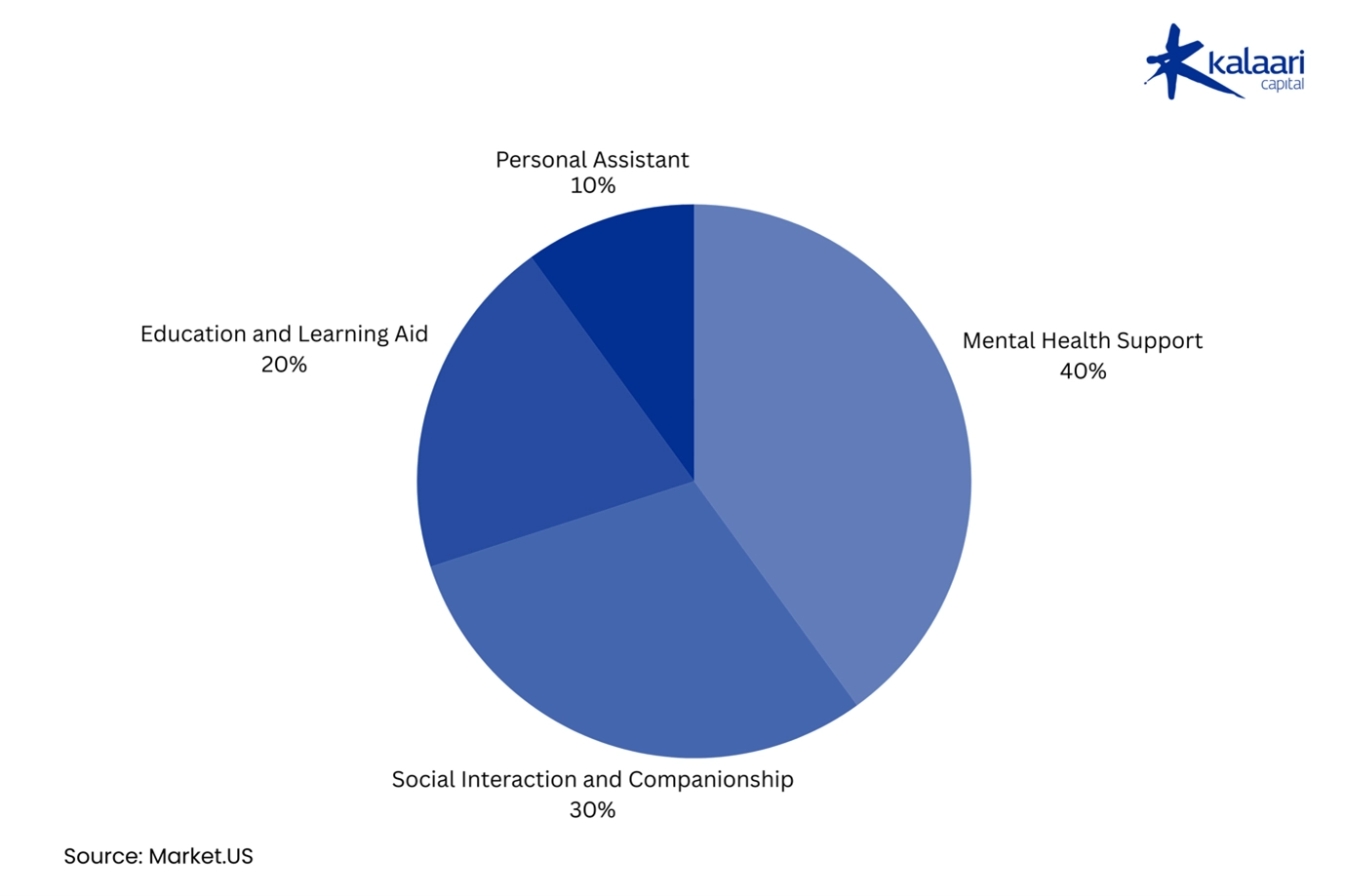
Mental health is emerging as a prominent area where AI companions excel.
Designed with sophisticated emotional intelligence and empathetic conversational capabilities, companions can mimic some responsibilities traditionally held by counselling services. They provide immediate, round-the-clock support—something rarely feasible with human therapists alone. For instance, platforms such as Wysa and Woebot have effectively demonstrated their potential in managing mild to moderate anxiety and depression symptoms through evidence-based cognitive behavioral therapy (CBT) and mindfulness techniques. A recent meta-analysis involving 18 randomized controlled trials with over 3,400 participants found significant improvements in depressive and anxiety symptoms among users interacting regularly with AI chatbots. Another study reported a remarkable 64% greater reduction in depression symptoms for chatbot users compared to control group.
It can also be classified according to input and output modes. Those are text-based, voice-based or even multimodal. The text-based AI Companion segment is expected to dominate with a 45% market share in 2024, as users gravitate towards simple, intuitive, and easily accessible AI interactions.
Text is a product of the The “Minimum Viable Interaction” Principle. Text interfaces present fewer choices than multimodal platforms. Users don’t need to decide how to interact (speak, gesture, type)—they just type. This simplicity aligns with the paradox of choice: fewer options increase engagement, especially for casual users.
Text creates a diary-like intimacy. Users often anthropomorphize AI companions, treating chat logs as personal journals. Startups like Character.ai report users spending 2+ hours daily crafting elaborate text-based relationships with AI personas, a behavior less common today with voice interfaces. [Given the pace of voice innovation in AI, this may very well also grow significantly in the years to come.]
On the unit economics front, thanks to recent advances in LLMs, the cost of consumer entertainment and companionship is collapsing by 75% per year, as shown below. The cost declines associated with AI could create an explosion in consumer applications and platforms.

India too, stands at a unique inflection point in the adoption of AI companions. With close to half a billion social media users, the country already demonstrates a robust appetite for digital social connections. Even a conservative adoption rate of 15% would translate to 75 million AI companion users – a market size larger than the entire population of most countries.
A compelling opportunity lies in the untapped vernacular market. This trend is validated by success stories like EloElo (a Kalaari Portfolio company), which achieved 200% year-on-year growth and connected 85 million users by focusing on regional language content and culturally relevant experiences. The platform’s success in Tier 2 and 3 cities, which account for over 80% of its traffic, demonstrates the immense potential for AI companions that speak India’s languages. Tomorrow, these interactions can be moderated and served by AI.
Market Map
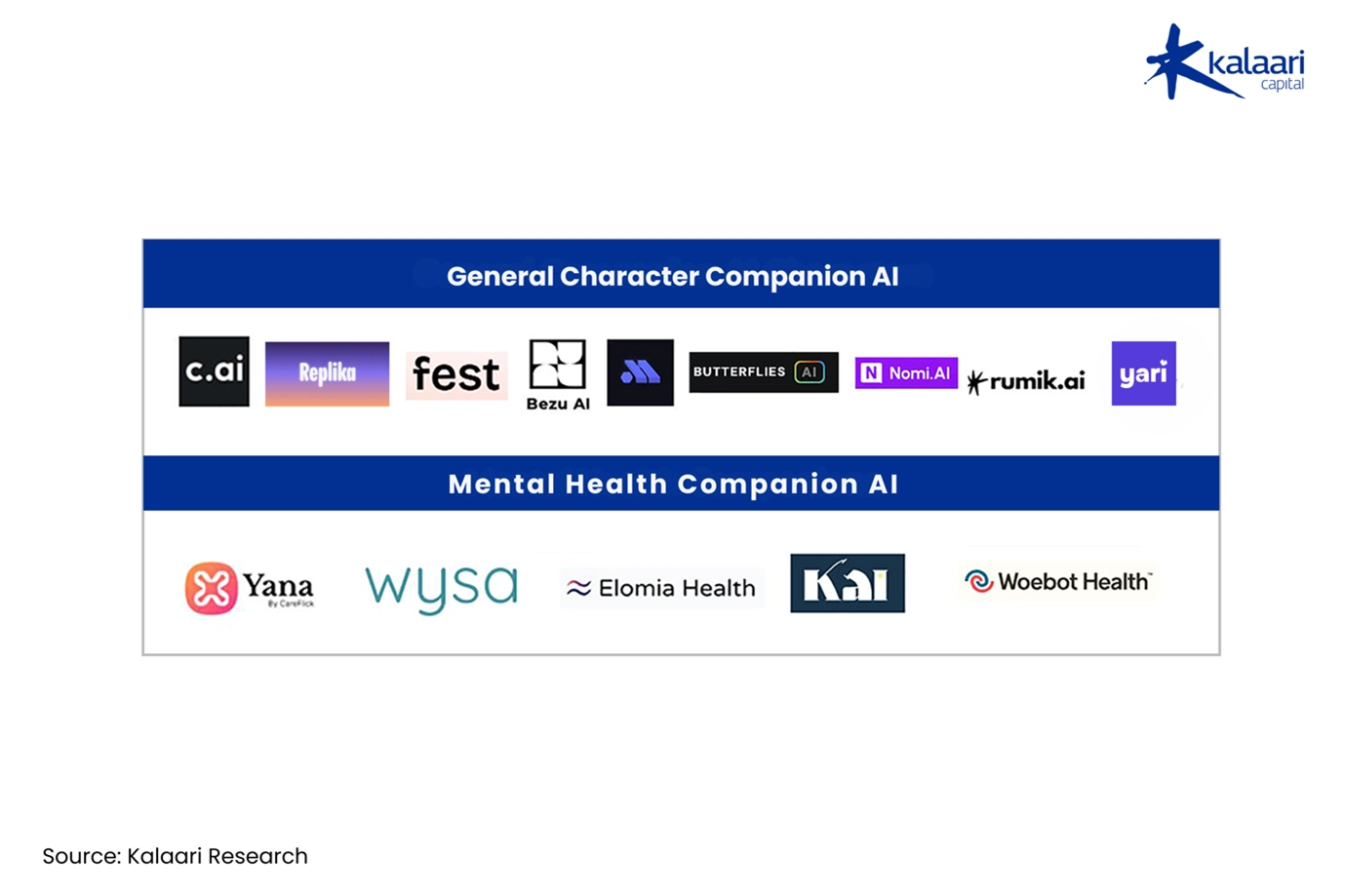
So what stops massive immediate adoption?
Like every transformative application, AI companions come with their own nuanced problems in that of the edge cases where the AI chatbot has talked about/suggested a course of action which may be dangerous or not to the liking of one or more parties.
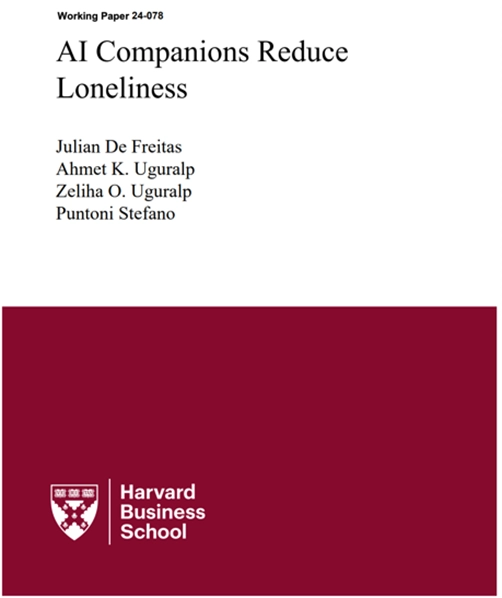
On one side, AI companions have shown initial measurable outcomes towards solving loneliness problems. Let’s take this study done by HBS for Instance which tackled this question by looking at whether AI companions – think sophisticated chatbots designed for emotional support – could help combat loneliness. And their findings might surprise you.
The Research highlights how AI companions effectively combat loneliness by analyzing millions of conversations and conducting extensive experiments involving over 1,000 participants. AI companions, such as Replika, notably outperformed general AI assistants (e.g., ChatGPT) in reducing loneliness, receiving consistently high user ratings. The experiments showed that the positive effects were immediate, sustained over time, and greater than participants anticipated. While not substitutes for human connection, AI companions offer meaningful emotional support, especially when real-world interactions are limited.
But, there are potential risks associated with AI companions. While guard-railing these systems is crucial, it’s far more complex than simply filtering out harmful words or topics. Consider this: what happens when your AI companion, despite best intentions, steers a vulnerable user down a problematic path of thinking? The challenge isn’t just about preventing explicit harmful content – it’s about the subtle ways these interactions might shape someone’s worldview or decision-making process.

This creates a significant bottleneck for widespread adoption of AI companions. While these applications might help thousands or even millions of people combat loneliness effectively, the potential risks in edge cases could be severe enough to warrant careful consideration. It’s a classic scale versus safety dilemma: how do we make these companions accessible enough to help the many while shielding people from potential vulnerabilities?
Kalaari Outlook:
At Kalaari we believe that the AI companion space represents a fascinating intersection of technological innovation and fundamental human needs. The early data from studies and market adoption presents a compelling case for AI companions to address modern loneliness. However, the path forward requires thoughtful innovation, particularly around safety and scalability.
We see three key areas where founders can create significant value in this space.
First, the development of robust safety frameworks that go beyond simple content filtering.
Second, the creation of culturally-adapted companions that understand local contexts, that is especially crucial in diverse markets like India and Europe.
Third, the building of scalable infrastructure that can support millions of meaningful interactions while maintaining quality and safety.
As AI technology evolves rapidly, novel forms of human-AI interactions will emerge:
- Adaptive Tone and Emotional Flexibility:
AI companions will increasingly adopt dynamic conversational styles—shifting seamlessly between serious counseling modes to casual banter or humor based on context or user mood - Entertainment-Centric Experiences:
AI companions could evolve beyond traditional conversational roles into fully-fledged entertainment entities—hosting trivia games, narrating personalized stories, performing comedic routines, or engaging in interactive role-play scenarios - Immersive Multimodal Interactions:
Integration with augmented reality (AR) and virtual reality (VR) technologies will enable deeply immersive companionship experiences. - Context-Aware Companionship:
Future AI companions will leverage advanced contextual understanding—drawing from real-time data such as location, activity tracking via wearables, or even biometric signals—to provide highly personalized interactions tailored precisely to users’ immediate needs or emotional states. - Social Integration and Community Building:
AI companions could facilitate social interactions among users by connecting individuals with similar interests or emotional needs within virtual communities.
Indian market also presents a compelling opportunity, with over 500 million people in the primary demographic sweet spot. Cultural factors like the transition from joint to nuclear families and urban migration are creating new patterns of loneliness that AI companions could potentially address.
We’re excited to hear from founders who can demonstrate deep understanding of both AI technology and human psychology. The ability to build scalable yet safe AI companion experiences, focusing on solving real emotional needs apart from showcasing technical capabilities, will be crucial.
This represents one of the most exciting opportunities in consumer tech today – the chance to build businesses that can scale globally while making a meaningful impact on one of society’s most pressing challenges.








